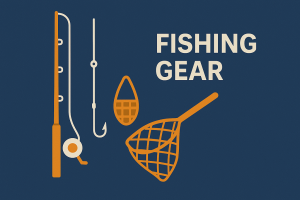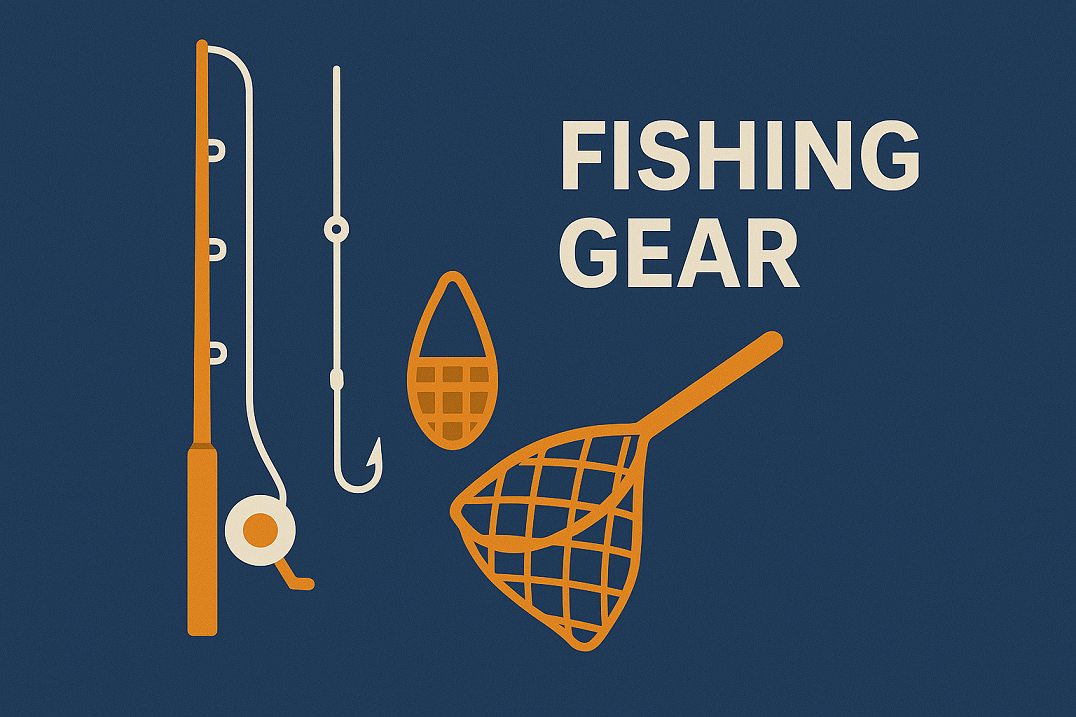Discover everything about fishing gear—types, tools, applications, and innovations. This expert guide is designed for enthusiasts looking to master the tools of the trade.
 🎣 Why Fishing Gear Is More Than Just Hooks and Lines
🎣 Why Fishing Gear Is More Than Just Hooks and Lines
Did you know the global fishing gear market is expected to exceed $20 billion by 2028? From traditional rods to AI-powered sonar devices, fishing gear has evolved into a vital toolkit for everyone from weekend anglers to marine biologists and commercial fleets.
Whether you’re just getting started, managing a charter company, working on maritime innovation, or preparing for a marine science course, understanding fishing gear is essential to grasping both sportfishing and sustainable fishing industries.
What Is Fishing Gear?
Fishing gear encompasses all equipment used to catch aquatic species, ranging from simple handlines to sophisticated industrial trawls. These tools vary dramatically between recreational anglers, commercial fisheries, and scientific researchers, with designs adapted to specific environments, target species, and regulations. Modern gear prioritizes sustainability through selective catching mechanisms and eco-friendly materials while maintaining efficiency. The choice of equipment significantly impacts catch success, environmental impact, and compliance with maritime laws.
Fishing gear refers to any equipment used to catch aquatic animals, primarily fish, in freshwater or saltwater environments. It includes both active gear (like trawls and longlines) and passive gear (like nets and traps).
🔍 Key Categories:
-
Recreational Fishing Gear: Rods, reels, lures, tackle boxes, etc.
-
Commercial Fishing Gear: Trawlers, seine nets, dredges, longlines, etc.
-
Scientific & Survey Gear: Tagging tools, sonar systems, sample nets
-
Traditional & Artisanal Gear: Handlines, spears, basket traps
✅ Fishing gear choices vary based on fishing method, environment, target species, and regulatory frameworks.
⚙️ Core Components of Recreational Fishing Gear
Recreational fishing relies on carefully matched components that work in harmony – rods with proper action and power, reels with smooth drag systems, and lines with precise weight ratings. Modern tackle incorporates advanced materials like carbon fiber rods and braided polyethylene lines, while ergonomic designs improve casting accuracy and reduce fatigue. Essential accessories like landing nets, hook removers, and tackle organizers complete the system, creating a balanced setup for specific fishing techniques and target species. These components continue evolving with smart technology integration and eco-conscious designs.
| 🎒 Equipment | 🔍 Purpose | 💡 Notes |
|---|---|---|
| Fishing Rod | Casts bait/lure into the water | Varies by power, action, and material |
| Reel | Controls line tension and retrieves catch | Spinning, baitcasting, fly reels |
| Line | Connects bait to rod; strength varies | Choose line weight based on species and gear |
| Hooks | Catches fish by mouth or body | Circle, J-hooks, treble hooks |
| Bait/Lure | Attracts fish visually or by scent | Live bait, artificial lures, scented soft plastics |
| Tackle Box | Organizes accessories, weights, hooks, etc. | Waterproof, compartmentalized models preferred |
| Net | Used to land the catch or handle fish safely | Rubberized nets reduce fish injury |
| Pliers & Tools | For hook removal, cutting lines, adjusting gear | Must-haves for safety and efficiency |
⚓ Commercial & Industrial Fishing Gear Types
Commercial fishing operations utilize specialized gear designed for maximum efficiency at scale, including otter trawls that sweep seafloors, purse seines that encircle schools, and longlines stretching miles with hundreds of hooks. Each gear type presents unique advantages – gillnets selectively catch by size while traps allow live capture – but also requires careful management to prevent overfishing. The industry increasingly adopts modified gear like turtle excluder devices and acoustic deterrents to reduce bycatch, responding to both ecological concerns and regulatory pressures.
| ⚙️ Type | 📍 Used In | 🐟 Common Catch |
|---|---|---|
| Trawl Nets | Deep sea & midwater | Shrimp, cod, haddock |
| Purse Seines | Coastal & pelagic fisheries | Sardines, tuna, mackerel |
| Gillnets | Coastal & freshwater | Salmon, trout, catfish |
| Longlines | Open ocean | Swordfish, tuna |
| Dredges | Sea beds | Clams, scallops |
| Traps & Pots | Nearshore or bottom areas | Lobsters, crabs, eels |
🌱 Modern trends focus on reducing bycatch and minimizing habitat disruption using selective gear designs and biodegradable materials.
🎓 Why Fishing Gear Matters for Learning, Research, and Industry
Fishing equipment serves vital roles beyond harvest – as educational tools fostering STEM skills, research instruments for marine biologists, and safety-critical systems for maritime professionals. Students use standardized gear for population surveys, while conservationists develop modified designs to protect endangered species. The $50B global fishing gear industry drives technological innovation while facing sustainability challenges, making gear development a focal point for environmentalists, engineers, and policymakers alike.
✅ For Beginners & Teenagers:
- Teaches hand-eye coordination, observation skills, and respect for nature
- Encourages outdoor exploration and basic survival skills
🎓 For Students & Researchers:
- Used in field studies on aquatic biodiversity, ecosystem health, and species tagging
- Essential for catch-per-unit-effort (CPUE) analysis in fisheries science
⚓ For Maritime Professionals:
- Understanding gear types is vital for navigation safety, crew training, and fleet operations
- Required for STCW certification and commercial license compliance
💼 For Companies & Marketers:
- Fishing gear manufacturers lead product innovation, sustainability, and digital marketing campaigns
- Outdoor brands tap into fishing culture through gear design and storytelling.
📈 Latest Trends in Fishing Gear (2024–2025)
The fishing gear market is undergoing a tech revolution with GPS-enabled reels, smart sonar integration, and biodegradable materials becoming mainstream. Commercial fisheries adopt IoT-equipped nets that monitor catches in real-time, while recreational brands emphasize modular designs and ergonomic improvements. Sustainability dominates innovation with plant-based fishing lines, non-toxic weights, and gear recovery programs gaining traction across sectors. These advancements aim to balance fishing efficiency with environmental responsibility in changing aquatic ecosystems.
🌱 Sustainable Gear Innovations
- Biodegradable fishing lines, barbless hooks, and eco-friendly lures are becoming standard
- Shift toward gear tagging for traceability and recovery
🤖 Smart Fishing Technology
- GPS-enabled reels, smart sonar, and AI-based fish finders improve catch rates
- Apps integrated with gear for logging catches, locations, and weather
🧠 Ergonomic & Modular Designs
- Focus on lightweight materials, custom grip rods, and modular tackle systems
- Rise in multi-species rods and interchangeable reel platforms
📊 Data-Driven Commercial Gear
- Sensor-equipped nets track species and bycatch in real-time
- IoT-based fleet management systems for commercial gear optimization
💡 Real-World Applications & Case Studies
Practical applications demonstrate fishing gear’s evolving role – researchers in the Mediterranean deploy hydroacoustic gear to study climate change impacts, while Florida charters implement circle hooks to improve catch-and-release survival rates. Major manufacturers like Shimano now blend digital platforms with traditional equipment, creating connected ecosystems where anglers access sonar data and catch logs through smartphone apps. These case studies reveal how gear innovation addresses ecological challenges while enhancing user experience across fishing disciplines.
🧪 Field Research in the Mediterranean
Students at a marine institute in Italy use plankton nets and hydro-acoustic gear to measure biodiversity changes linked to temperature shifts.
🛥️ Eco-Tourism Fishing Charters
A Florida-based charter uses circle hooks and venting tools to reduce injury in catch-and-release practices, enhancing sustainability and visitor education.
🏢 Marketing & Brand Awareness
Fishing gear brands like Shimano and Abu Garcia invest in sustainable packaging, influencer partnerships, and interactive web stores to engage younger markets.
❓ FAQs: People Also Ask
❓What is the most important fishing gear for beginners?
A basic spinning rod and reel combo with monofilament line and a few hooks and lures is enough to get started.
❓Is fishing gear different for saltwater and freshwater?
Yes. Saltwater gear is typically heavier, corrosion-resistant, and designed for larger species.
❓What is the best fishing gear brand?
Top brands include Shimano, Penn, Daiwa, Abu Garcia, and Rapala—each offering different specialties in reels, rods, and accessories.
❓How do I choose the right fishing gear?
Consider:
- Species targeted
- Water type (fresh/salt/brackish)
- Experience level
- Fishing technique (casting, trolling, jigging, etc.)
📖 Interesting Facts & Industry Insights
-
🧭 Japan and the USA are leaders in fishing gear innovation
-
🐠 Selective gear use reduces bycatch by up to 60% in some fisheries
-
📦 Over 30% of fishing gear waste can be traced to lost or abandoned nets (ghost gear)
🧭 Conclusion
Fishing gear has transformed from primitive tools into precision-engineered instruments for science, leisure, commerce, and conservation. Whether you’re casting a line on the weekend, conducting fish population studies, or managing a fishing operation, the right gear can make all the difference.
🎯 Explore More:
Visit MaritimeEducation.com to learn about fishing gear, careers in maritime industries, environmental stewardship, and marine science tools.
📘 References & Further Reading
-
FAO – Fishing Gear Types: www.fao.org/fishery/geartype
-
NOAA Fisheries – Sustainable Fishing Practices: www.fisheries.noaa.gov
-
Global Fishing Gear Market Forecast 2024–2028 – Allied Market Research
-
Shimano & Daiwa Brand Sites – Technical guides and innovations
-
UNEP – Ghost Gear and Marine Pollution Reports

